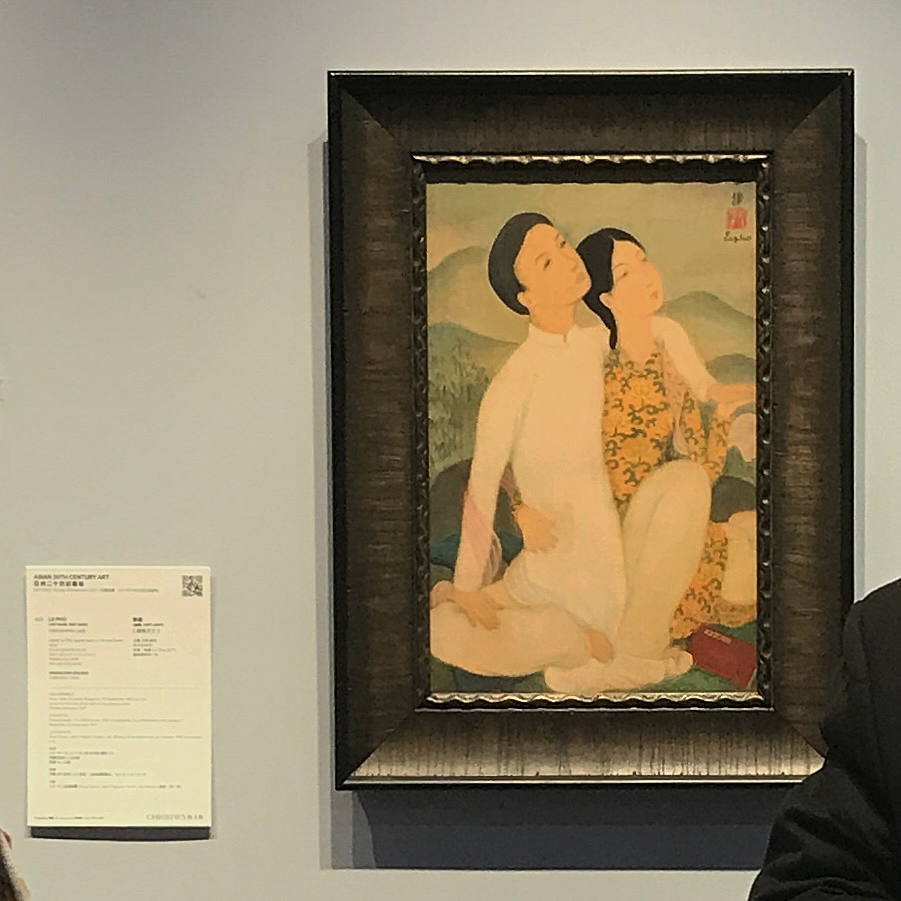Le Pho (Vietnam/France, 1907-2001)
Idylle (Idyll)
signed 'Le Pho', signed again in Chinese (upper right)
ink and gouache on silk
42 x 29 cm. (16 1/2 x 11 3/8 in.)
Painted in the 1940s
one seal of the artist
Price Realised HKD 2,000,000 at Christie's Hong Kong, 26 November 2017

VIETNAMESE PAINTING ON SILK
In the late 1920s some students of the Fine Arts School of Hanoi developed painting on silk under the patronage of their director Victor Tardieu (1870-1937). Amongst them, Nguyen Phan Chanh (1892-1984), Tran Binh Loc (1914-1941), Tô Ngoc Van (1906-1954), Vu Cao Dam (1908-2000) and some others were primarily using this medium. At that time however, Le Pho (1907-2001) and Mai Thu (1906-1980) still favoured working with oil on canvas.
Mentioning 'painting on silk' could lead to a misunderstanding of the exact medium. In fact, it would be more appropriate to talk about 'painting on silk applied on paperboard'. It is Le Pho himself who explained personally to me in 1991 about his technique which required a certain amount of preparation: take a paperboard, cut a piece of silk to the dimension on which you trace two lines of glue, the first one horizontal and the second one vertical, you cover with the glue every centimetre to the edge and leave the preparation to dry a whole night. Once dried, the preparation creates a fusion between the silk, the paperboard and the glue and provides an original surface to work on. Afterwards, the painter will apply delicately the gouache and the black ink.
Yannick Vu-Jakober, the daughter of Vu Cao Dam specified to me in 1996, that her father had the habit of scrunching the silk and would let it set before he would glue it. In the early 1940s, Vu Cao Dam used a mix of diluted ink to immerse the silk in to create depth and shadows, as can be seen in Young Vietnamese Girl (Lot 403). In the fifties, he created a combined medium, different to gouache, in which he would add egg but still on silk.
Le Pho in his 'Romanet' period of 1945 to the mid-60s, (Lot 409, 410 and 419) also created a combined medium including oil paint to get more thickness and would add a layer of varnish on his silk.
Mai Trung Thu on the other hand, outlined with sober colours for his earlier works such as Légende de Fées (Fairy Tale) (Lot 416), Beauté (Beauty) (Lot 417) and would stay with this technique using black ink and gouache as a more classical style: the gouache is applied by layers. By overlapping and with the scrapings of pigment together, an illusion of fine patterns is created. The very few colours used are kept separated.
The diversity of techniques used would ultimately influence greatly the style of the work: the ink and gouache is generally set in thin layers, and are immediately absorbed by the silk-paper and it is challenging for the artist (as opposed to the use of oil on canvas). The artist must use a vivacious and precise brush stroke to give a unique freshness to the work.
The Colonial Exhibition in Paris, 1931 was a turning point in the success of 20th century Vietnamese painting on silk. Indeed, so many great works were exhibited for this event. Great success was achieved: the paintings were well received by the public and was also published in the very important and influential journal of the time 'L'illustration'. Collectors were entranced with the works on display and led to continued appreciation for this art form. Le Pho, Mai Thu, Vu Cao Dam would subsequently have great exhibitions. From Paris, they will exhibit in Algeria (under French territory at the time). For example, Idylle (Lot 415) by Le Pho was sold in Oran in the Pasteur Gallery on 21 November 1944.
From 1963, the year of their signing with the American Gallery Wally Findlay, Le Pho and Vu Cao Dam would only use oil on canvas and abandoned painting on silk. Mai Thu, on the contrary, would specialize solely in silks paying particular attention to very original neat frames he would create himself to enhance his work. Mai Thu would honour and celebrate a traditional Confucian Vietnam. Women are at the centre of his work: many of his central subject were the young lady, L'Écharpe Jaune (The Yellow Scarf) (Lot 401), Femme à l'Éventail et à l'Oiseau (Lady with a Fan and a Bird) (Lot 414) or the mother and child theme, Femme à l'Enfant (Mother and Child) (Lot 418). A much rarer subject as well for him would be Jeune Européenne dans un Jardin Japonais (Young European Lady in a Japanese Garden) (Lot 407) with his epochal depiction of a European lady set in an Oriental garden setting.
Mai Thu painted many children as well and his main characters used to take a large part of the painting and progressively they would become smaller on silk notably represented by A Girl Playing the Lute and a Mandarin Scholar in an Interior (Lot 413) and share the space with the decor.
The art pieces presented here show the excellence of their talent at its best and carried out to the full by Vietnamese painters, paving the way for an original and unique new art form and appreciation.
Jean-François Hubert
Senior Expert, Vietnamese Art











